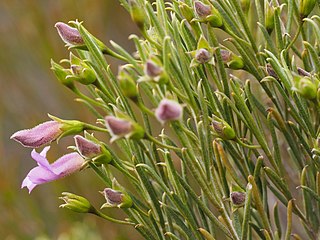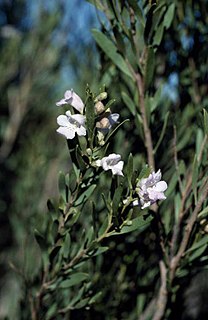Diocirea is a genus of flowering plants in the figwort family, Scrophulariaceae. The genus is endemic to a small area in the south-west of Western Australia and is intermediate in character between Eremophila and Myoporum. There are four members of the genus, all of which are small shrubs with stems and leaves which produce a resin making the plants appear bluish-green. Neither the genus, nor any of the species had been described before 2007 although a few specimens had been collected as Eremophila elachantha. Despite their limited distribution, they often occur in populations of several thousand individual plants, forming a dense ground cover.
Diocirea acutifolia is a plant in the figwort family, Scrophulariaceae and is endemic to a small area near Norseman in Western Australia. The branches and leaves produce sticky resin which sometimes covers the whole plant making it appear bluish grey. This species is distinguished from the three others in the genus by its leaves which are longer than 6 millimetres (0.2 in) and the prominent resin glands on its stems.

Diocirea microphylla is a plant in the figwort family (Scrophulariaceae), and is endemic to a small area near Coolgardie in Western Australia. It is a low shrub with thin branches and minute leaves pressed against the stems. It is readily distinguished from the other three species in the genus by its tiny leaves.
Diocirea ternata is a plant in the figwort family, Scrophulariaceae and is endemic to a small area near Balladonia in Western Australia. It is a low shrub with a restricted distribution but which often occurs in large numbers, forming a dense ground cover. It is readily distinguished from the other three species in the genus by its unusual leaf arrangement.
Eremophila appressa, commonly known as wispy poverty bush, is a plant in the figwort family, Scrophulariaceae and is endemic to two remote locations in the central west of Western Australia. Its most unusual feature is its leaves which, at least when young, are less than 2.5 mm (0.1 in) long and 1 mm (0.04 in) wide and are glued to the stem by resin.
Eremophila aureivisca, also known as Rason poverty bush, is a flowering plant in the figwort family, Scrophulariaceae and is endemic to a small area in the south-east of Western Australia. It is a shrub with narrow, sticky, shiny leaves and pale purple flowers, known only from the edge of Lake Rason but may be more widely distributed in this remote area.
Eremophila clavata is a flowering plant in the figwort family, Scrophulariaceae and is endemic to the south-west of Western Australia. It is a low, dense, spreading shrub with narrow grey, club-shaped leaves and pink to purple, sometimes blue flowers.

Eremophila compressa is a flowering plant in the figwort family, Scrophulariaceae and is endemic to a small area in the south west of Western Australia. It is an erect shrub whose leaves have 2 or 3 prominent teeth near their ends, and white or cream-coloured flowers.
Eremophila cryptothrix is a flowering plant in the figwort family, Scrophulariaceae and is endemic to the Pilbara region of Western Australia. It is a shrub with sticky stems due to the presence of resin, narrow leaves, coloured sepals and white, pale pink or pale blue flowers.

Eremophila labrosa is a flowering plant in the figwort family, Scrophulariaceae and is endemic to Western Australia. It is a shrub with many hairy branches arising from near ground level, narrow, hooked leaves and mauve and blue flowers.

Eremophila mirabilis is a flowering plant in the figwort family, Scrophulariaceae and is endemic to Western Australia. It is a shrub with narrow leaves, brightly coloured sepals and petals growing in two widely separated areas.

Eremophila paisleyi is a plant in the figwort family, Scrophulariaceae and is endemic to Australia. It is a rounded, broom-shaped shrub with white or lilac-coloured flowers which occurs in Western Australia, South Australia and the Northern Territory.
Eremophila pallida is a flowering plant in the figwort family, Scrophulariaceae and is endemic to Western Australia. It is a small, spreading shrub with hairy stems, leaves with a few serrations and reddish purple to violet flowers.
Eremophila petrophila is a flowering plant in the figwort family, Scrophulariaceae and is endemic to Western Australia. It is a tall, erect, open shrub with rough branches, narrow, sticky leaves and pale lilac-coloured flowers.
Eremophila praecox is a flowering plant in the figwort family, Scrophulariaceae and is endemic to Australia. It is a small, broom-like shrub with small leaves and purple and white flowers.
Eremophila prolata is a flowering plant in the figwort family, Scrophulariaceae and is endemic to Western Australia. It is an erect shrub with a rounded top, prominently ridged, hairy branches, narrow leaves and white to deep lilac-coloured flowers.
Eremophila setacea is a flowering plant in the figwort family, Scrophulariaceae and is endemic to Western Australia. It is an erect shrub with narrow, glabrous leaves, hairy sepals and light blue to purple petals.
Eremophila shonae is a flowering plant in the figwort family, Scrophulariaceae and is endemic to Western Australia. It is an erect shrub or a low spreading shrub, depending on subspecies and has very sticky branches and leaves due to the presence of large amounts of resin. The leaves are narrow and the flowers are mauve to purple and white inside with purple spots.

Eremophila spuria is a flowering plant in the figwort family, Scrophulariaceae and is endemic to Western Australia. It is an erect, open shrub with narrow leaves and blue, lilac, purple or white flowers and is a common and widespread species.

Eremophila veneta, commonly known as metallic-flowered eremophila is a flowering plant in the figwort family, Scrophulariaceae and is endemic to Western Australia. It is a low, spreading, sticky shrub with dark green leaves and bluish-green petals.






